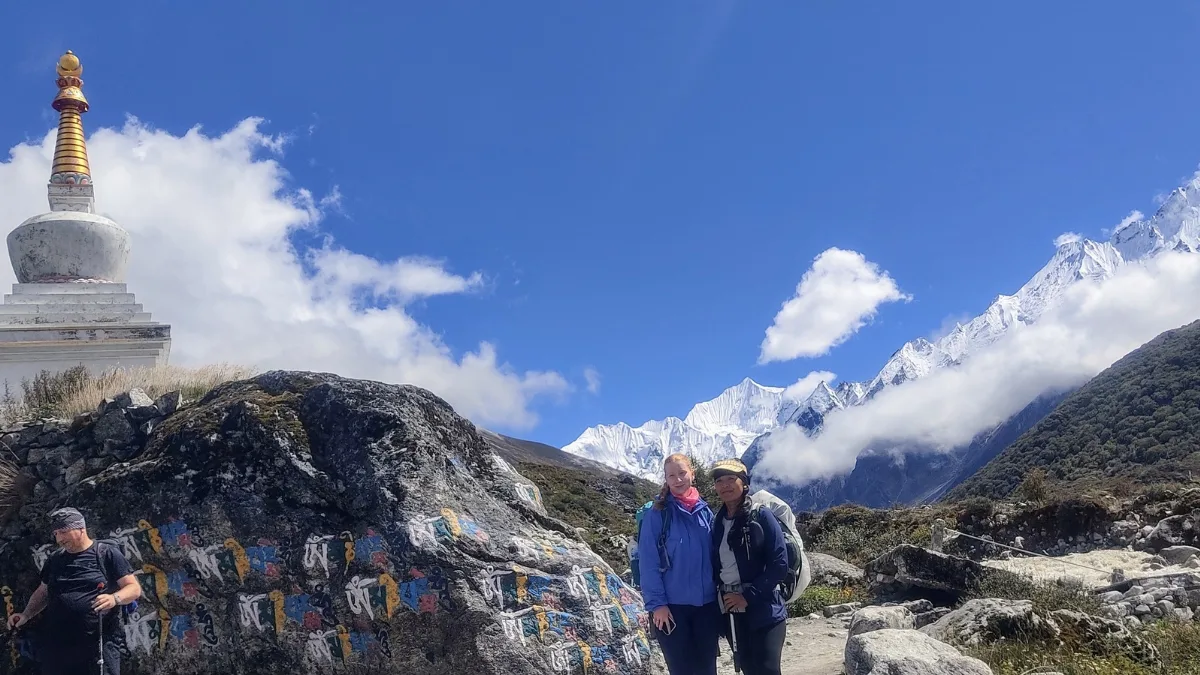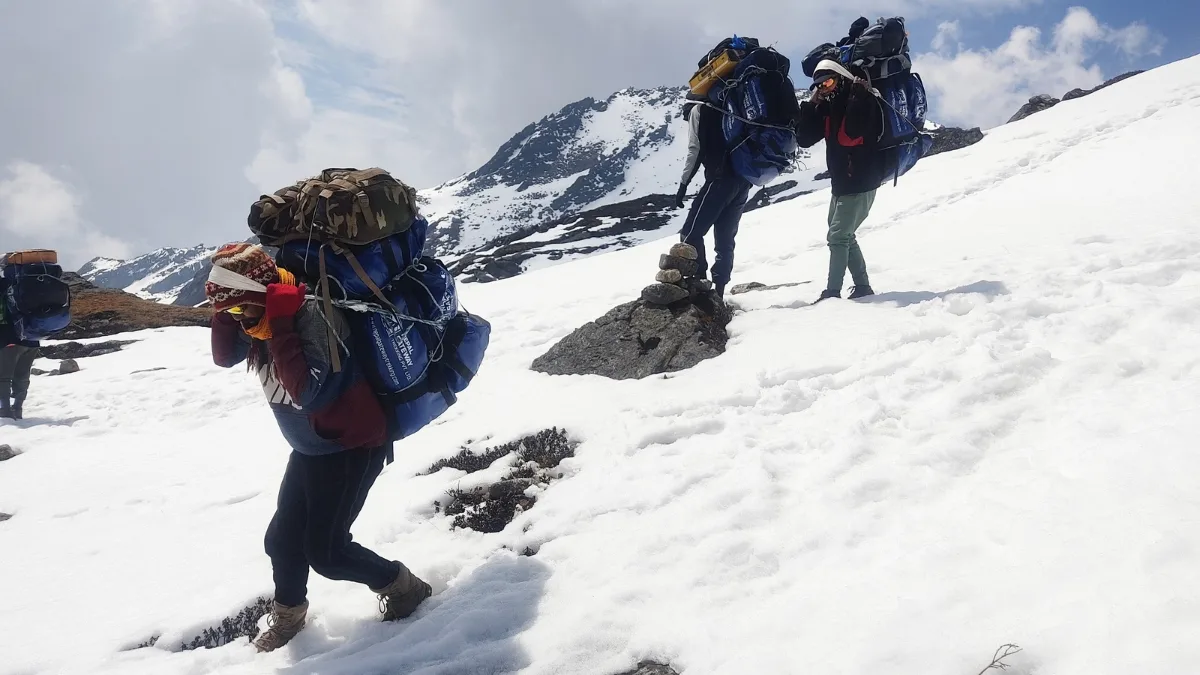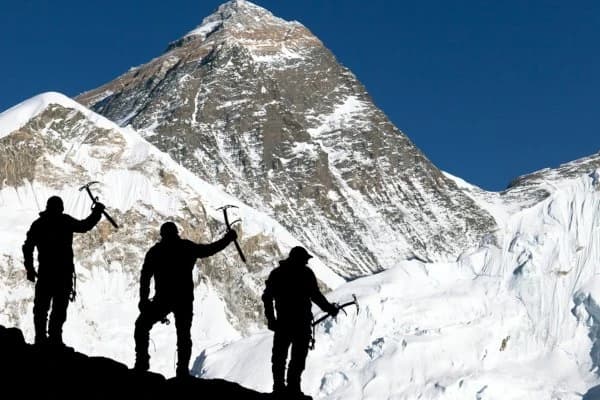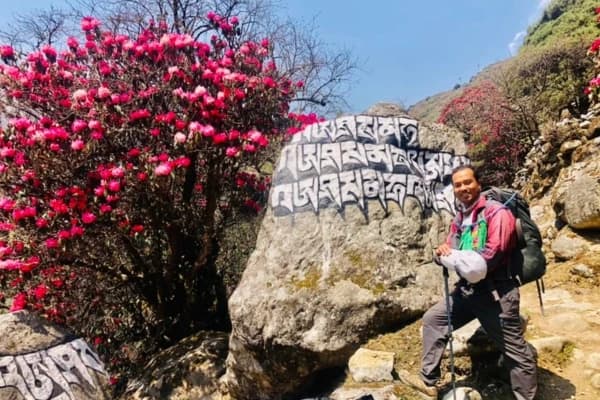Spring (March–May) and Autumn (September–November) are the best seasons for the Langtang Gosaikunda Trek, offering clear Himalayan views, pleasant weather, and vibrant scenery.
The Langtang Gosaikunda trek lies in Nepal’s Langtang National Park, reaching altitudes of over 4,380 meters at the sacred Gosaikunda Lake. Choosing the best time for Langtang Gosaikunda trek ensures clear skies, stable temperatures, and breathtaking Himalayan views.
The Langtang Gosaikunda trek is a special journey where you walk through bright rhododendron forests full of flowers in spring and green trees in other seasons. You will cross beautiful suspension bridges over fast rivers, adding fun to your walk. The trail goes through small Tamang villages where friendly people welcome you and share their culture and stories.
The trek ends at Gosaikunda Lake, a clear mountain lake surrounded by tall snowy peaks. With its amazing nature, local culture, and spiritual feeling, this trek is a wonderful experience for everyone.
But when’s the perfect time to go? This guide explains everything: the best months, seasonal highlights, trail conditions, weather details, packing tips, and personalized recommendations for every type of trekker.
Why Timing Makes a Difference for Langtang Gosikunda Trek?
Timing is everything when it comes to trekking in Nepal. The Langtang Gosaikunda Trek sits between 1,500 m and over 4,300 m, meaning temperatures, weather, and accessibility vary dramatically by season.
1. Weather & Visibility
Clear skies are what you dream about, and seasons make or break those views.
- Spring brings mild temperatures (10–20 °C at lower altitudes) and crystal-clear mornings. It also offer breathtaking views of Langtang Lirung (7,234m), Ganesh Himal, and Dorje Lakpa.
- Autumn offers the most stable weather and sharpest views of Langtang Lirung.
- Monsoon hides the peaks behind clouds.
- Winter adds snow, cold winds, and limited daylight, but magical serenity.
2. Trail Conditions & Accessibility
The trail begins at Syabrubesi and weaves through Langtang Valley toward Gosaikunda Lake.
- Spring & Autumn: Roads and paths are dry and well-marked.
- Monsoon: Landslides and leeches are common, expect slippery, muddy terrain.
- Winter: High passes like Lauribinayak Pass (4,610 m) may be covered with snow, limiting access.
3. Flora, Fauna & Culture
Nature's calendar adds magic to your journey. Rhododendron blooms Langtang forests explode with crimson, pink, and white flowers each April and May. Wildlife including red pandas, Himalayan tahr, and langur monkeys become more active during warmer months. The sacred Janai Purnima festival in August draws thousands of Hindu and Buddhist pilgrims to Gosaikunda Lake, offering profound cultural immersion alongside the Tamang and Sherpa heritage villages you'll encounter.
4. Crowd Levels & Accommodation
Langtang is less crowded than Everest or Annapurna, but Autumn and Spring still see busy teahouses, especially near Kyanjin Gompa and Gosaikunda. In Winter, you’ll have lodges almost to yourself, but services are limited.
5. Budget & Logistics
Prices shift slightly with the seasons:
- Peak (Spring & Autumn): Standard pricing, but book early.
- Off-Peak (Monsoon & Winter): Discounts available, yet some routes or teahouses may close.
If you want to explore deeply about the Tamang culture, you are suggested to take trek to Langtang Tamang Heritage and explore their culture and lifestyle.
Seasons Overview

|
Season |
Months |
Verdict |
Highlights |
|
Spring |
March–May |
Excellent |
Flowers bloom, mild weather, rhododendrons, clear mornings |
|
Autumn |
Sept–Nov |
Top Choice |
Crystal skies, stable weather, festival energy |
|
Winter |
Dec–Feb |
Challenging |
Snowy paths, quiet trails, cold but peaceful |
|
Monsoon |
Jun–Aug |
Risky/Solitude |
Lush greenery, fewer crowds, muddy & cloudy |
Langtang Gosaikunda Trek in Each Season
The Langtang Gosaikunda Trek starts from Syabrubesi, Rasuwa District, just 122 km north of Kathmandu. This proximity makes it one of Nepal’s most accessible high-altitude treks.
Spring (March–May)
- Temperature: 15–20 °C daytime, 0–5 °C at night near Gosaikunda.
- Visibility: Excellent, though some late-afternoon haze.
- Flora/Fauna: Colorful flowers, lively forests, and possible red panda sightings.
- Culture: Local Tamang communities celebrate Buddhist festivals and plant crops.
During spring, Langtang Gosaikunda weather stays mild and stable, making it perfect for trekking. Daytime temperatures range between 10°C to 20°C, providing ideal conditions for high-altitude climbs and photography. March brings the first rhododendron blooms Nepal's national flower painting hillsides in vibrant hues. By April, the spectacle peaks with rare Himalayan blue poppies, orchids, and cobra lilies adorning the trail.
Wildlife becomes active again after winter. If you’re patient and start early, you might see red pandas searching for food in bamboo forests or musk deer moving on rocky hills. The weather gets warmer, making trekking comfortable, but it can feel very hot in May at lower areas.
Photography enthusiasts find spring irresistible. Wildflower close-ups contrast beautifully with snow-capped peaks. Morning fog creates mystical atmospheres in Langtang valleys. The moderate crowds allow peaceful moments without winter's isolation.
- Pros: Perfect for photography, comfortable trekking, and stable weather.
- Cons: Moderate crowds in popular sections.
Tip: Bring a lightweight down jacket for higher altitudes. Nights near the lake can still be chilly.
Thinking of trekking through Langtang? Explore our Langtang Valley Trek - 10 Days
Autumn (September–November)
- Temperature: 10–15 °C daytime, 0 °C or below at night at high points.
- Visibility: Outstanding, some of the clearest views of the Himalayas all year.
- Culture: Major festivals like Dashain and Tihar add energy to the region.
- Crowd Level: Highest, especially in October.
Autumn is widely known as the best time for the Langtang Gosaikunda trek due to crystal-clear skies and moderate temperatures. Many trekkers consider October the most beautiful month for Langtang region trekking in Nepal. After the rainy monsoon season, the skies clear up, mountains look bright and beautiful, and local festivals bring the villages to life. During this time, big festivals like Dashain and Tihar fill the villages with lights, music, and colorful decorations. Daytime temperatures are usually between 10 and 15 °C, but it can get very cold at night, especially in higher areas.
The air after the monsoon is very clear, giving some of the best mountain views you can see all year. Crossing places like Laurebinayak Pass offers amazing 360-degree views, perfect for photos. At night, the stars shine brightly in the clean mountain air.
Because autumn is so popular, many trekkers come in October, so lodges get busy and trails can be crowded. The festivals make the season even more special with a lively and welcoming atmosphere. November is still a great time with fewer people, cooler nights, and dry, firm trails. Tea houses are open and ready with warm meals and cozy spaces.
Prices for flights and jeep rides may be higher during this busy time. To get the best experience, start your trek early in the morning for the best light and book your places to stay well ahead of time.
- Pros: Ideal weather, crisp air, colorful cultural experiences.
- Cons: Full lodges, need early booking, slightly pricier flights, and jeeps.
Tip: Start your trek early in the morning to enjoy the best light for photography.
Winter (December–February)
- Temperature: 5–10 °C in lower altitudes, –6 °C or colder above 4,000 m.
- Visibility: Generally clear, but shorter daylight hours.
- Trail Conditions: Snow or ice at high passes; some routes closed.
- Accommodation: Many teahouses close for the season, so the number of tea houses are limited.
Winter in Langtang feels magical and peaceful. The trails are covered with snow, and the lakes often freeze, making it seem like a dreamy Himalayan world. At lower places, temperatures are between 5 and 10 °C, but high up above 4,000 meters, it can get as cold as –6 °C or even colder.
Trekking in winter is challenging but rewarding, with snow-covered landscapes and fewer trekkers. The sky is mostly clear, but the days are shorter. Snow and ice on mountain passes can make walking difficult, and some paths may be closed because of bad weather. Many teahouses close in winter, so there are fewer places to stay, and you must plan your trip carefully.
The best parts of winter trekking are quiet trails, fewer people, and very clear mountain views. But the cold can be very strong, which brings risks like frostbite and blocked paths. To stay safe and comfortable, you should bring warm gear like a sleeping bag for –10 °C, thick boots, and microspikes to walk on ice.
- Pros: Peaceful, fewer trekkers, crystal-clear views.
- Cons: Extreme cold, risk of frostbite or snow blockage.
Many ask, “Is it safe to trek to Gosaikunda in December?
Yes, with proper gear and guidance, winter trekking offers serene snow views and quiet trails.
Monsoon/Summer (June–August)
- Temperature: 20–25 °C at lower levels, cooler up high.
- Visibility: Cloudy with occasional sun breaks.
- Trail Conditions: Muddy, leech-prone, and landslide risk.
- Culture: One of the spiritual highlights of Janai Purnima is the Gosaikunda pilgrimage.
The monsoon season turns Langtang into a green and lively place. The rain helps the forests and valleys grow, making everything look fresh and bright. Temperatures at lower areas are between 20 to 25 °C, while it is cooler higher up. The skies are usually cloudy, and sometimes the sun shines through. Trails can get muddy and slippery, which makes walking harder. You may also find leeches and need to be careful of landslides. Fewer people trek during this time, so the trails are quiet, and prices for places to stay and travel are lower.
One special event during the monsoon is the Gosaikunda pilgrimage at Janai Purnima, where locals and trekkers join together for a spiritual celebration. Even though the rain can be challenging, the monsoon season gives a fresh and green trekking experience for those ready to handle wet weather.
- Pros: Quiet trails, vibrant greenery, lower costs.
- Cons: Slippery terrain, heavy rainfall, transportation delays.
Although monsoon season brings lush greenery, heavy rain can make trails slippery. However, it’s also the best time for photographers who love misty mountain views and fewer crowds along the Langtang Gosaikunda trek route.
Tip: Use trekking poles, wear waterproof boots, and keep electronics in dry bags.
Step into the wild beauty of Langtang. Plan your trek today with Nepal Gateway Trekking, where every path leads to peace.
Pros & Cons of Each Season for Langtang Gosaikunda Trek

|
Season |
Good Points |
Challenges |
Best For |
|
Spring |
Nice weather, flowers, clear mornings |
Trails can be a bit busy |
Photographers, new trekkers |
|
Autumn |
Best mountain views, festivals, steady weather |
Crowds and higher prices |
Families, beginners, culture fans |
|
Winter |
Quiet trails, beautiful snow views |
Cold nights, fewer places to stay |
Experienced trekkers, those wanting peace |
|
Monsoon |
Green and fresh nature, fewer people |
Muddy trails, rain, leeches |
Travelers on a budget, flexible adventurers |
Tip: Always carry a -10 °C sleeping bag, insulated boots, and microspikes for safety during winter.
How Timing Affects Trekking Conditions & Planning?
1. Altitude & Acclimatization
Altitude sickness is a genuine risk beyond 3,000 m.
- Include a rest/acclimatization day at Langtang Village or Kyanjin Gompa.
- Stay hydrated and ascend gradually.
- Carry Diamox if you’re prone to AMS (consult your doctor first).
2. Trail Difficulty & Safety
The Langtang Gosaikunda trek is moderately difficult but choosing the right season helps reduce altitude sickness risks and enhances your overall experience.
- Spring/Autumn: Well-marked, stable, safe.
- Monsoon: Watch for leeches and slippery slopes.
- Winter: Ice patches near Gosaikunda; use trekking poles and spikes.
Local guides know the terrain best. Hire one if you’re new to the area.
3. Accommodation & Access
- Spring/Autumn: Lodges fully operational.
- Winter: Some close above 3,800 m confirm before setting off.
- Monsoon: Check the road to Syabrubesi (can be blocked by landslides).
4. Gear & Packing Checklist
- For Spring/Autumn: Layered clothing, rain shell, down jacket, trekking boots.
- For Winter: Thermal base layers, –10 °C sleeping bag, gloves, gaiters, spikes.
- For Monsoon: Waterproof boots, poncho, quick-dry clothes, insect repellent.
Tip: Pack smart using compression bags and label gear by use (sleeping, clothing, safety).
5. Health & Safety Tips
- Drink 3–4 L of water daily.
- Avoid alcohol at altitude.
- Always have travel insurance covering helicopter rescue.
- Carry basic medicines (paracetamol, electrolytes, anti-diarrheal).
Recommendation – Choose Your Best Time For Langtang Gosaikunda Trek Based on Goal
|
Goal |
Recommended Season |
Reason |
|
Best overall experience |
Autumn |
Perfect weather and views |
|
Colorful flowers & wildlife |
Spring |
Nature in full bloom |
|
Peace & solitude |
Winter |
Empty trails, serene landscapes |
|
Budget travel |
Monsoon |
Lower prices, fewer tourists |
|
Cultural experiences |
Autumn |
Dashain, Tihar, and Janai Purnima festivals |
Final Thoughts
If you want a Himalayan trek with beautiful mountains, local culture, and peaceful feelings, the Langtang Gosaikunda Trek is a great choice. In spring, the valleys are full of colorful flowers. Autumn has clear, blue skies. Winter is quiet and calm. Monsoon makes the forests green and lively.
Whichever season you pick, get ready well, pack the right gear, and respect the people and nature. This trek is more than a trip, it’s a special experience that can change how you see the world.
Ready to Plan Your Trek?
Book your Langtang Gosaikunda Trek for 2026 with Nepal Gateway Trekking get expert guides, tailored itineraries, and safe adventures through Nepal’s scenic heartland.
Contact Nepal Gateway Trekking Now to reserve your dates and get a free itinerary consultation.
FAQs
What is the best month for clear Himalayan views?
October is the best month for clear Himalayan views and stable weather.
Can I trek Langtang Gosaikunda in winter?
Yes, but you’ll need proper gear and experience. Snow often blocks passes.
Are tea-houses open in January and February?
Some close, especially near Gosaikunda. Please check this info with your guide before starting the trek.
Do I need different gear for monsoon?
Yes, you’ll need different gear for monsoon-like rain covers, waterproof boots, and anti-leech socks.
How does cost vary between spring and autumn?
Autumn can be slightly pricier due to demand, but both season offers the same.
What festivals happen during the trek?
Dashain, Tihar (autumn), and Janai Purnima (monsoon) are celebrated locally during the trek.
Is the trek suitable for families in March?
Yes, the trek is suitable for families in March. The weather is mild, trails are safe, and lodges are welcoming.
How long is the Langtang Gosaikunda Trek?
The Langtang Gosaikunda Trek is 7–10 days. It depends on your pace and route variation.
Which wildlife or flora is visible in April vs October?
April brings rhododendron blooms and red pandas; October features crisp views and clear skies.
What permits are required?
You’ll need a TIMS card and Langtang National Park Permit. So, always carry ID and passport copies.





